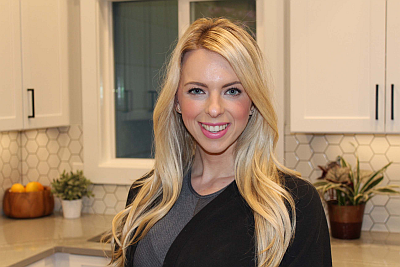We all know the signs of diet season: Bathroom scales come out of hiding, gym memberships are renewed, and folks turn to anything that will help them look their best in a bathing suit come summer.
But for many people losing weight is actually a year-round endeavor. Three-quarters of American adults report being concerned about their weight, and nearly half (43%) followed a specific diet according to a recent study. As a country, we spend more than $70 billion on weight-loss products and services every year.

Amy Anderson, Registered Dietitian Nutritionist
The concern is well-placed. “The average American weighs around 20 pounds more than they did 30 years ago,” explains Amy Anderson, Registered Dietitian Nutritionist and Nutrition Program Manager for Aramark Business Dining. “Being significantly overweight or obese comes with many well-known health risks, including heart disease and type 2 diabetes.”
Achieving a healthy weight for your body type is certainly a worthy goal—but, with so much information out there, what is a dieter to make of it all? We tapped Amy’s expertise to help you navigate the world of dieting, including many of those popular diets you keep hearing about. (Even before getting started, Amy reminds us how important it is to consult with your doctor or dietitian before embarking on a major change to your eating or exercise habits!)
HOW TO WIN (AND FAIL) AT DIETING
Thanks to years of research, health and nutrition experts have a good idea of what leads to lasting weight loss—and what doesn’t.
The core of the problem is that many popular diets revolve around strict rules, with long lists of food to avoid. You may lose weight at first, but that progress can quickly evaporate. Unsurprisingly, this framework often leaves a dieter feeling deprived and defeated. These are just a few of the hallmarks of a fad diet.
“Highly restrictive diets are hard to stick to, especially when you’re socializing or dining out. Deprivation diets don’t have a track record for longevity, which is why we call them the ‘For Now’ approach to eating,” Amy tells us.
However, a more holistic eating pattern does tend to lead to lasting results. It goes like this: Decrease the amount of low quality foods you consume (think ultra-processed food with lots of added sugar, salt and saturated fat) and up your intake of fresh, whole foods.
“When you fill up on fruits, vegetables, whole grains, lean proteins and other nutritionally dense foods, it tends to leave less room for the not-so-good stuff,” Amy explains. “We call this the ‘For Life’ approach to eating. It is delicious and satisfying, and it can help you manage your weight and also be Healthy For Life.”
DIETS WE LOVE
 That said, it’s human nature to categorize things and to gravitate toward clear rules and structure. That explains, in part, why so many diets exist out there. “People like rules because they take the guesswork out of dieting. We’re busy, and we just want to know what and how to eat,” says Amy.
That said, it’s human nature to categorize things and to gravitate toward clear rules and structure. That explains, in part, why so many diets exist out there. “People like rules because they take the guesswork out of dieting. We’re busy, and we just want to know what and how to eat,” says Amy.
Your diet doesn’t have to have a specific name (unless you name it after yourself!) But we happen to be big fans of two well-known, trustworthy diets that have stood the test of time. Both diets emphasize putting more healthy plant foods at the center of the plate. A concept of adding more produce to the diet (particularly fruit and non-starchy vegetables) which has been directly linked to lower weight.*
Mediterranean Diet
Th Mediterranean Diet style of eating emphasizes a variety of fruits, vegetables, whole grains, beans and legumes. Also on the menu are foods with healthy fats like seafood, nuts and olive oil. This diet includes moderate amounts of proteins like eggs, dairy and poultry—and limited amounts of red meat.
This nutritious eating pattern has been associated with improved cognition and mental health, as well as reduced risk for type 2 diabetes, cancer, heart attack, and stroke.
- Pro Tip: You may notice that sweets and treats don’t make the list here—but that doesn’t mean they are completely off limits! “Moderation and mindful eating can guide you toward healthy eating without requiring a specific diet,” adds Amy. “I love that the Mediterranean diet focuses on fresh fruits after dinner as a sweet treat.”
Plant-Forward Diet (a.k.a. Flexitarian, Plant-Based)
Eating plant-forward simply means putting more plants on your plate while reducing the amount of meat you eat. You don’t have to say good-bye to animal protein forever; just focus on eating mostly plant-based foods.
The delicious choices include fruits, veggies, whole grains, nuts, beans, lentils and seeds. Eating plant-forward has been shown to lower the risk of heart disease, type 2 diabetes and certain cancers while making it easier to maintain a healthy weight. It’s good for the planet, too, as plant-forward choices help reduce your carbon footprint and the amount of greenhouse gases that end up in the atmosphere.
- Pro Tip: It’s important to note that a plant-based diet is still subject to many pitfalls. Just because a food comes from a plant doesn’t mean it’s healthy. There are lots of ultra-processed, plant-based foods packed with sugar, salt or refined carbohydrates that make this list. The key to success with this approach is to go for plant-forward choices that are minimally processed, whole foods.
![]()
POPULAR DIETS, DEMYSTIFIED
 OK, now for the reality check. We totally understand the allure of popular diets that promise quick weight loss. With so much buzz surrounding them, it’s natural to be at least a little curious. But many of these diets come with significant drawbacks.
OK, now for the reality check. We totally understand the allure of popular diets that promise quick weight loss. With so much buzz surrounding them, it’s natural to be at least a little curious. But many of these diets come with significant drawbacks.
“These diets tend to exclude major food groups, which lead to those feelings of deprivation, not to mention a lack of certain nutrients,” Amy warns.
To guide you, she describes four popular diets you may have on your radar. If you haven’t started one of these diets, your best bet is to talk with your doctor or dietitian before you do.
Since each diet focuses on restriction and, in some cases, deprivation—it’s very important that you and your healthcare provider are mapping out a safe path together. For those who have taken the leap after consulting with a healthcare provider, Amy provided some information that can help you to be successful with this kind of diet plan.
Whole30
With this diet, you eliminate certain foods for (you guessed it!) 30 days: Alcohol, sugar, artificial sweeteners, grains, legumes and dairy. Then you gradually reintroduce them back into your routine. Whole30 is big on whole foods including lean meats, seafood, eggs, fruits and veggies. It can be helpful if you’re trying to identify a food that is causing health issues, such as allergies, intolerances, or digestive woes.
- Pro Tip: Don’t skimp on the reintroduction phase. “You don’t want to go too long without any one food group, because you’ll miss out on important nutrients,” Amy states.
Paleo
Short for paleolithic, this diet mimics how our hunter-gatherer ancestors ate. Paleo encourages plant-based foods, animal proteins (meats, poultry, eggs, fish, seafood), and healthy fats like olive oil. Processed food, added sugar and grains are discouraged. Paleo is also open to modification; some followers include dairy products, legumes, and even “ancient” whole grains like quinoa or amaranth in their meal planning.
- Pro Tip: Stick to lean cuts of meat and plant-based proteins. Too much saturated fat (found in animal products) isn’t optimal for heart health.
Keto
The ketogenic diet restricts carbohydrates, forcing your body to burn fat for energy instead, which leads to weight loss. We’re talking super low-carb—less than 50g per day—which is about what you’ll find in two bananas. All the fat and protein in a Keto diet may keep you feeling full, but you also miss out on eating vegetables, fruits and other nutrient-dense foods. There are ways to replace missing nutrients—some important vitamins and minerals that are missing in this diet can be found in organ meats—but not too many people find things like liver an appealing food to eat or include regularly in their diets.
- Pro Tip: Remember that we need all macronutrients (protein, carbs, fat) for overall wellbeing. You can lower your carb intake without going full Keto. As Amy puts it: “Healthy carbs are our main source of energy. They’re good for us and not the enemy! What’s more, long-term Keto may put you at risk for liver, kidney or heart conditions due to high saturated fat and cholesterol.”
Intermittent Fasting (IF)
With this diet, you cycle between intervals of eating and fasting. During the fasting period, you only consume calorie-free, unsweetened beverages like water, coffee and tea. Common patterns include 16 hours of fasting followed by 8 hours of eating or alternating full days of eating and fasting. People gravitate toward IF for its simplicity and the fact that no food is forbidden. It can also be helpful if you are prone to mindless late-night snacking (a common foe!)
- Pro Tip: Follow a balanced diet and watch your portion sizes. “You shouldn’t break your fast with a free-for-all. If you overeat, it defeats the purpose,” Amy points out. Plus, know that fasting can cause light-headedness, weakness, irritability and low energy. Schedule physical activity around when you’ll be eating, especially if you’re an athlete.
![]()
EATING FOR LIFE

Get Recipe: Grilled Salmon Panzanella Salad
Food is a very personal choice. What works for you won’t necessarily work for your best friend or neighbor. If you’re considering changing your diet, here are some thought-starters to help determine whether your plan will put you on the path to success.
- Can you see yourself eating this way for the next year—and beyond?
- Do the changes work for your real life, including your family, your schedule and your social life?
- Does the diet include a wide variety of foods from the major food groups?
- Do you have the freedom to choose foods you love in moderation?
- Will this diet give you enough energy to do the things you love, whether that’s a daily jog or chasing after the kids?
- Will this way of eating help you reach your health goals?
- Will it have a positive effect on your sleep, mood and mental wellbeing?
In the end, perhaps the best dieting advice is this: Don’t call it a “diet” at all! Instead, think of your daily food choices as a lifestyle. You’re eating not just for the right-now, but for a lifetime of good health.
“The magic word here is ‘sustainable,’” Amy reassures us. “The best eating pattern is a well-balanced one that helps you achieve your health goals and that you can stick to. After all, food is meant to be enjoyed!”
*In a 2015 Harvard T.H. Chan School of Public Health review that involved 133,468 men and women, each daily serving of fruit led to about a half-pound weight loss, and each serving of non-starchy vegetables was linked to a quarter-pound weight loss.
Note: Since everyone’s health history and nutritional needs are so different, please make sure that you talk with your doctor and a registered dietitian to get advice about the diet and exercise plan that‘s right for you.

